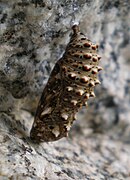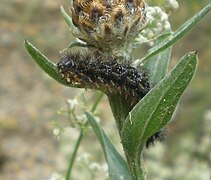Melitaea phoebe
You can help expand this article with text translated from the corresponding article in French. (August 2018) Click [show] for important translation instructions.
|
| Knapweed fritillary[1] | |
|---|---|

| |
| Male | |

| |
| Female | |
| Scientific classification | |
| Domain: | Eukaryota |
| Kingdom: | Animalia |
| Phylum: | Arthropoda |
| Class: | Insecta |
| Order: | Lepidoptera |
| Family: | Nymphalidae |
| Genus: | Melitaea |
| Species: | M. phoebe
|
| Binomial name | |
| Melitaea phoebe | |
| Synonyms[1] | |
|
Papilio phoebe Denis & Schiffermüller, 1775 | |
Melitaea phoebe, also known as the Knapweed fritillary,[1] is a butterfly of the family Nymphalidae.[2] It is found in the Palearctic realm, except the northernmost locations. Previously it also included Melitaea telona which was recently revalidated as a distinct cryptic species.
Description
[edit]This section may require copy editing. (March 2024) |
Melitaea phoebe's wingspan is 34–50 mm. The largest Melitaea of the Old World, at least certain of its forms. The forewing is much more pointed than in the previous species; equally variable in both colour and distinctness of markings. The black markings are usually united, in some cases even covering nearly the whole wing, but in other cases may be strongly reduced. It is characteristic for this species that the reddish yellow submarginal lunate spot situated between the two median veins reaches with its vertex considerably farther into the disc than the other yellow lunate spots. This is especially the case on the forewing, but also on the hindwing. The submarginal lunule between the 1 and 2 median veins projects farther basal than the others of the same row.[3] Wheeler (1903) gives a short description.[4]
-
Male
-
Male underside
-
Female
-
Female underside
-
Pupa
-
Larva
-
Larva
Biology
[edit]The butterfly flies from April to September depending on the location. The larvae feed on Plantago and Centaurea species (including Centaurea jacea).[citation needed]
Distribution and Habitat
[edit]M. phoebe is present in Europe, except in the northern part: England, Ireland, Northern France, Germany, Poland and Scandinavia. It is also found in North Africa (Morocco and Algeria),Turkey, Siberia and Center Asia (Mongolia and China).
The Knapweed fritillary lives in the flowery meadows.
Etymology
[edit]Named in the classical tradition. Phoebe is - in Greek mythology - one of the first generation of Titans, who were one set of sons and daughters of Uranus and Gaia.[citation needed]
References
[edit]- ^ a b c d e Melitaea phoebe[permanent dead link]. IUCN Red List.
- ^ Savela, Markku. "Melitaea phoebe (Denis & Schiffermüller, 1775)". Lepidoptera and Some Other Life Forms. Retrieved 23 June 2018.
- ^ Seitz. A. in Seitz, A. ed. Band 1: Abt. 1, Die Großschmetterlinge des palaearktischen Faunengebietes, Die palaearktischen Tagfalter, 1909, 379 Seiten, mit 89 kolorierten Tafeln (3470 Figuren).
 This article incorporates text from this source, which is in the public domain.
This article incorporates text from this source, which is in the public domain.
- ^ Wheeler, George. The butterflies of Switzerland and the alps of central Europe. London: Elliot Stock, 1903.








